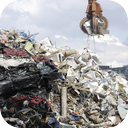(short preview of full seamless looping track)
Recycling Plant
This product is not available in the selected currency.
In Stock
Backordered
Out of Stock
Description
The enormous mounds of almost everything known to modern man surround you in heaps the size of mount everest. You feel lost in a never-ending landscape of old lawnmowers and metal cans as the plant workers walk around silently scanning the piles of trash as if they were the priests in this garbage temple city. Yet no matter how unattractive the area seems, you smile and thank the new age of industry for turning waste into something you want. Recycling is processing used materials (waste) into new products to prevent waste of potentially useful materials, reduce the consumption of fresh raw materials, reduce energy usage, reduce air pollution (from incineration) and water pollution (from landfilling) by reducing the need for "conventional" waste disposal, and lower greenhouse gas emissions as compared to virgin production. Recycling is a key component of modern waste reduction and is the third component of the "Reduce, Reuse, Recycle" waste hierarchy. In the strictest sense, recycling of a material would produce a fresh supply of the same material—for example, used office paper would be converted into new office paper, or used foamed polystyrene into new polystyrene. However, this is often difficult or too expensive (compared with producing the same product from raw materials or other sources), so "recycling" of many products or materials involves their reuse in producing different materials (e.g., paperboard) instead. Another form of recycling is the salvage of certain materials from complex products, either due to their intrinsic value (e.g., lead from car batteries, or gold from computer components), or due to their hazardous nature (e.g., removal and reuse of mercury from various items).
Opps
Sorry, it looks like some products are not available in selected quantity.



